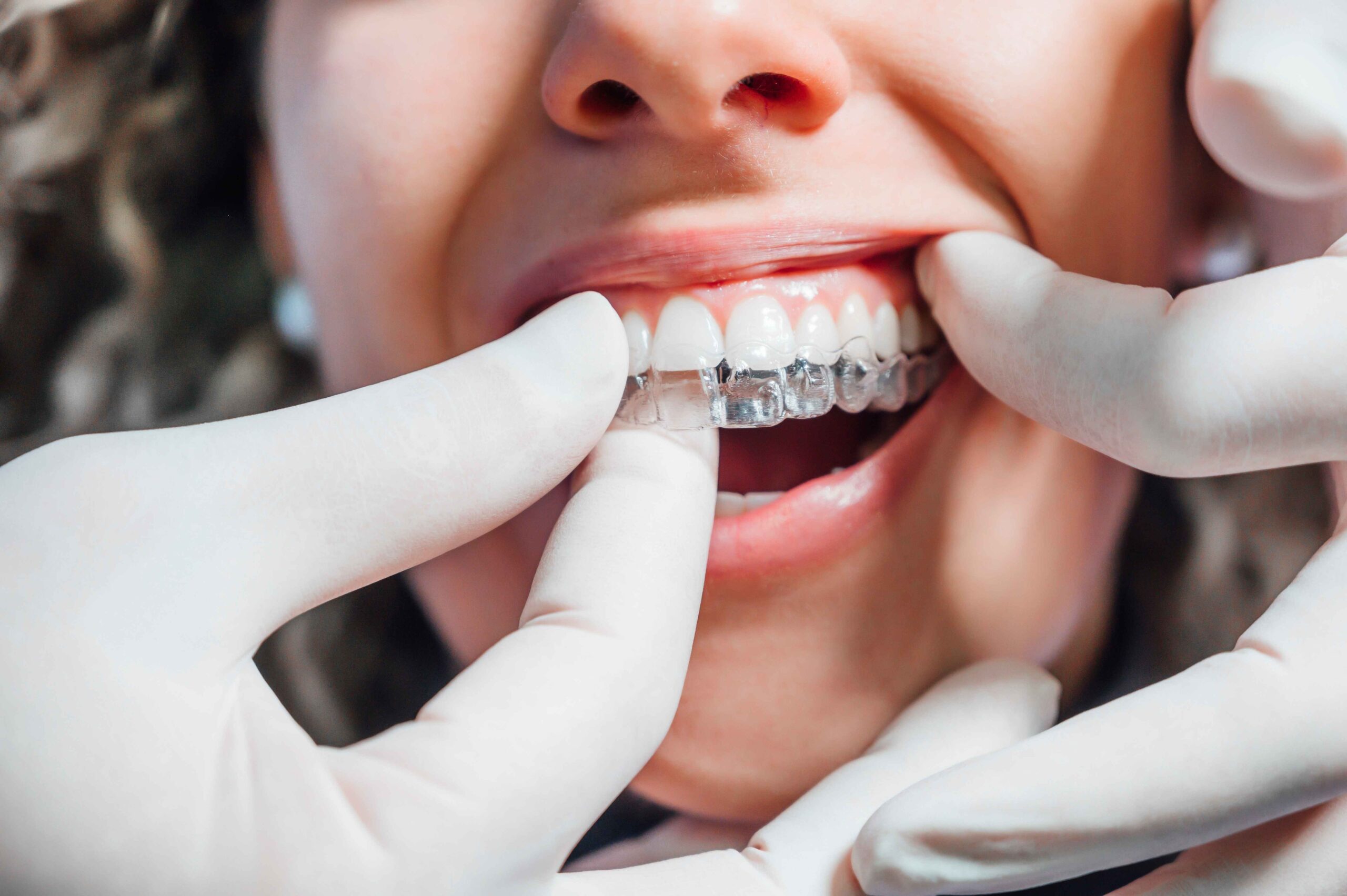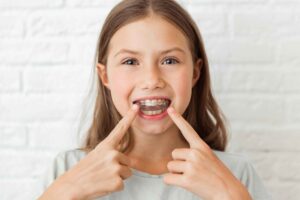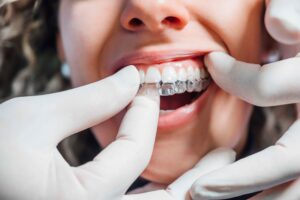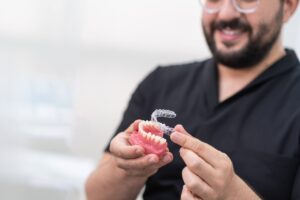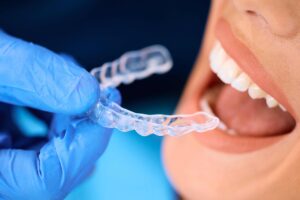Clear Aligners vs. Traditional Braces
Choosing between clear aligners and traditional braces for an underbite correction can be a complex decision. Both have their unique advantages and effectiveness in addressing orthodontic issues. Let’s break down these options to better understand which might be the best fit for one’s orthodontic needs.
Advantages of Clear Aligners
Clear aligners are becoming increasingly popular for fixing imperfect smiles due to the numerous advantages they offer over traditional braces. One of the primary draws of clear aligners is their discreet appearance. Unlike traditional braces, which are often quite noticeable, clear aligners are virtually invisible, making them an excellent option for adults and anyone who may feel self-conscious about wearing braces (Spark Aligners).
Comfort is another key advantage of clear aligners. They are custom-made to fit snugly over your teeth, reducing the risk of irritation to your gums or the inside of your mouth. Additionally, clear aligners are removable, which means you can take them out to eat, drink, brush, and floss, making them a more convenient and hygienic option compared to traditional braces (Touni Orthodontics).
| Advantages of Clear Aligners | |
|---|---|
| Discreet Appearance | Clear aligners are virtually invisible, allowing for a more natural-looking smile during treatment |
| Comfort | Custom-made to fit snugly over your teeth, reducing irritation |
| Removable | Can be removed for eating, drinking, brushing, and flossing, offering better oral hygiene |
Effectiveness of Traditional Braces
Despite the rising popularity of clear aligners, traditional braces remain a highly effective solution for correcting underbites and other orthodontic issues. A study published in the American Journal of Orthodontics and Dentofacial Orthopedics found that clear aligners and traditional braces were equally effective in correcting underbites.
Traditional braces are a tried-and-true method that has been used for decades to correct a wide range of orthodontic problems. They offer a high degree of precision and control, allowing orthodontists to make small adjustments to the position of the teeth as needed.
While traditional braces may not have the same aesthetic appeal or comfort as clear aligners, they can be an excellent option for individuals with severe underbites or other complex orthodontic issues that may not be manageable with clear aligners alone.
| Effectiveness of Traditional Braces | |
|---|---|
| Proven Method | Have been used for decades to correct a wide range of orthodontic problems |
| Precision and Control | Allow orthodontists to make small adjustments to the position of the teeth |
| Suitable for Complex Cases | Can handle severe underbites or other complex orthodontic issues |
The decision between clear aligners and traditional braces will ultimately depend on an individual’s unique orthodontic needs, lifestyle, and personal preferences. By understanding the advantages and effectiveness of each option, one can make an informed decision about the best path to a perfect smile.
Invisalign for Underbites
Invisalign uses a series of clear aligners to correct underbites gradually, offering an alternative to traditional braces when it comes to treating this orthodontic issue. However, the effectiveness of Invisalign can vary depending on the severity of the underbite.
Treating Mild to Moderate Underbites
Invisalign can be an excellent option for adults with slight underbites due to its discreet appearance and comfortable fit. These aligners are designed to gradually shift the teeth into the correct position, but the success of treatment depends on the individual’s unique case.
For underbites caused by misalignments of the teeth within the jaw, Invisalign can be used to effectively move the lower teeth back so they naturally sit behind the front teeth, providing a solution to this orthodontic issue.
Severe Underbites and Surgical Orthodontics
In some cases, Invisalign can be effective for treating Class 3 underbites. However, the suitability for each specific case will depend on severity and individual factors. In more severe cases, surgical orthodontics may be considered to ensure a comprehensive and effective treatment.
In extreme cases, braces may be combined with Invisalign as part of a comprehensive treatment plan. Nevertheless, it’s crucial to note that some underbite cases can’t be treated with Invisalign alone, and a professional dental examination is necessary to determine the best treatment plan (Southview Dentistry).
The clear aligners for underbite correction offer several advantages over traditional braces, including being discreet, comfortable, and beneficial for oral health. However, suitability for Invisalign treatment varies, and the decision should be made in consultation with an experienced dental professional.
Invisalign Treatment Process
The journey to a perfect smile with clear aligners for underbite involves several stages. It requires commitment and consistency from the patient for the best results.
Clear Aligners for Underbite Correction
Invisalign treatment involves wearing clear trays for at least 20 hours a day, removing them only for eating, brushing, and flossing. These trays gradually move the teeth into the correct position without the pain of brackets or wires typically associated with braces. The trays apply gentle, even pressure to the teeth, coaxing them into position, ultimately moving the teeth back into the correct position on the jaw over time Matthews Family Dentistry.
Invisalign can be used to move the lower teeth back so they naturally sit behind the front teeth to treat an underbite. In extreme cases, braces may be combined with Invisalign, and some underbite cases can’t be treated with Invisalign The Orthodontists.
| Orthodontic Issue | Can Invisalign Fix It? |
|---|---|
| Underbite | Yes (in most cases) |
| Crossbite | Yes |
| Open Bite | Yes |
| Crowded Teeth | Yes (depends on severity) |
Duration and Progress Monitoring
Invisalign treatment usually consists of wearing 18 to 20 aligner trays, with each tray worn for a week and kept in the mouth for 20 to 22 hours a day. Regular dental cleanings and follow-up visits during Invisalign treatment are recommended Matthews Family Dentistry.
The duration of the Invisalign treatment can depend on the complexity and severity of the underbite, with treatment times varying from patient to patient. However, most patients can expect to see noticeable improvements within a few months.
Monitoring progress is an essential part of the Invisalign treatment process. Regular check-ups with the dentist or orthodontist allow for adjustments to the treatment plan, ensuring the teeth are moving into their desired positions. Through these progress checks, patients can stay informed about their treatment and anticipate the journey to their perfect smile.
Benefits of Invisalign for Underbites
Invisalign, a popular type of clear aligner, offers several benefits over traditional braces when treating underbites. This section will discuss how the discreetness and comfort of Invisalign, along with its benefits to oral health, make it an attractive option for correcting underbites.
Discreetness and Comfort
One of the significant advantages of Invisalign is its discreet appearance. The clear aligners are virtually invisible, making them an excellent option for adults and teenagers who are self-conscious about their smiles.
In addition to being discreet, Invisalign aligners are also known for their comfort. Unlike traditional braces, which have metal brackets and wires that can irritate the inside of the mouth, Invisalign aligners are made from a smooth plastic material that fits snugly over the teeth. This minimizes discomfort and reduces the likelihood of mouth sores or injuries.
The aligners are designed to gradually shift the teeth into the correct position, but the success of the treatment depends on the individual’s unique case (Trident Smiles Dental). In extreme cases, braces may be combined with Invisalign, and some underbite cases can’t be treated with Invisalign (The Orthodontists).
Oral Health Benefits
In addition to its aesthetic and comfort advantages, Invisalign can also improve oral health. The aligners work by repositioning the teeth to eliminate gaps, correct overbites and underbites, and adjust crossbites.
By correcting these issues, Invisalign can help prevent unnecessary wear and tear on the teeth and gums. Misaligned teeth can lead to uneven tooth wear, tooth decay, gum disease, and even jaw problems. By bringing the teeth into proper alignment, Invisalign helps to mitigate these risks and promote better oral health (Touni Orthodontics).
Moreover, Invisalign aligners are removable, which means you can take them out to eat and clean your teeth. This allows for more thorough brushing and flossing, further contributing to better oral hygiene.
In summary, the use of Invisalign for underbite correction offers significant benefits, including being discreet, comfortable, and beneficial for oral health. These advantages make it a popular choice for those seeking a more convenient and less conspicuous alternative to traditional braces.
Factors Affecting Invisalign Treatment
When considering clear aligners for underbite correction, it’s important to bear in mind that certain factors can affect the suitability and success of the treatment. These factors encompass individual case specifics and any additional dental work required.
Suitability for Different Cases
Clear aligners are a versatile solution for a wide range of orthodontic issues, including crowded or crooked teeth, gapped teeth, overbites, underbites, and crossbites (Touni Orthodontics). They work by gently shifting teeth into the correct position over time.
Although Invisalign can be effective for treating Class 3 underbites, the suitability for each specific case will depend on a variety of factors, including the severity of the underbite and individual patient characteristics (Trident Smiles Dental). For instance, adults with slight underbites may find Invisalign to be an excellent option due to its discreet appearance and comfortable fit.
A study in the Journal of Clinical Orthodontics demonstrated a success rate of 78% in correcting Class III malocclusions (underbites) with clear aligners. It’s important to note, however, that complex cases may require surgical orthodontics in conjunction with Invisalign treatment.
Dental Work and Treatment Options
The Invisalign treatment process involves using a series of clear aligners to gradually correct underbites. These aligners are nearly invisible and comfortable, and are changed every two weeks to help shift the teeth towards their ideal positions. Regular check-ups are essential for ensuring progress and making adjustments if needed.
Treatment with clear aligners typically lasts between 12-18 months, which can be up to two times faster than traditional metal braces. Clear aligners also feature a discreet blue dot that indicates whether the aligners have been worn for the required amount of time each day, aiding in the effective repositioning of teeth within the estimated timeframe.
Clear aligners are designed to be easy to insert and remove for activities like eating and brushing teeth. This allows patients to maintain good oral hygiene routines during treatment.
In sum, the effectiveness of clear aligners for underbite correction relies heavily on the patient’s individual case and compliance with the treatment plan. Regular dental check-ups and maintaining good oral hygiene practices are essential to ensure a successful outcome.
Clear Aligners vs. Braces for Orthodontic Issues
Orthodontic treatments often involve a choice between traditional braces and clear aligners. Each option offers its own unique benefits and drawbacks, making it crucial to consider a variety of factors before deciding on the best treatment method.
Orthodontic Solutions Comparison
Clear aligners work best for minor to moderate orthodontic issues, like slightly crooked teeth or small gaps. For more complex cases, such as severe overcrowding or bite misalignments, traditional braces are typically a better option as they offer more precise and comprehensive tooth movement for faster treatment times overall (Touni Orthodontics).
| Orthodontic Issue | Clear Aligners | Traditional Braces |
|---|---|---|
| Slightly Crooked Teeth | Suitable | Suitable |
| Small Gaps | Suitable | Suitable |
| Severe Overcrowding | Less Suitable | More Suitable |
| Bite Misalignments (including underbites) | Less Suitable | More Suitable |
If you have an underbite, clear aligners may not be able to fix these issues on their own, as they are limited in their ability to move teeth vertically. In such cases, traditional braces may be recommended to move your teeth and jaws into proper alignment, which may even require combining orthodontic treatment with surgery in some instances (Touni Orthodontics).
For younger patients, especially children and teens, clear aligners may not be the best option as they require a high level of responsibility and compliance. Clear aligners need to be worn for at least 22 hours per day and only removed for eating and brushing, which children and teens may struggle with, potentially leading to treatment delays. Braces, being attached to teeth, eliminate the risk of forgetting to wear or losing them accidentally.
Clear aligners need to fit snugly around teeth to be effective. If you have dental work like bonding or bridgework, aligners may not fit properly. Traditional braces, on the other hand, can be fitted around existing dental work without any issue, as they do not rely on the same snug fit as aligners do.
Cost and Insurance Considerations
Clear aligners can be more expensive than traditional braces, particularly if multiple sets are needed over several months. While some insurance plans may cover the cost of clear aligners, others may only cover traditional braces. Hence, if concerned about the cost of orthodontic work, it is advisable to discuss treatment options with the orthodontic team and the insurance provider to find the best solution within one’s budget.
| Cost Factor | Clear Aligners | Traditional Braces |
|---|---|---|
| Initial Cost | Higher | Lower |
| Insurance Coverage | Variable | Usually Covered |
| Additional Costs (extra sets, replacements) | Possibly Higher | Typically Lower |
When considering clear aligners for underbite correction or any other orthodontic issue, the decision should always be made in consultation with a dental professional who can provide personalized advice based on your unique needs and circumstances.

